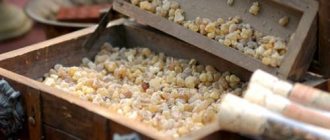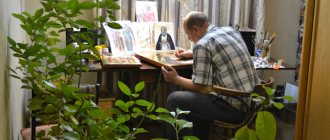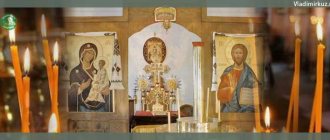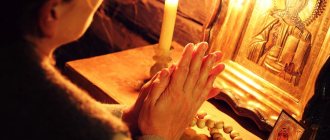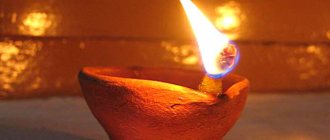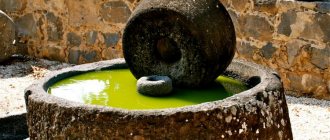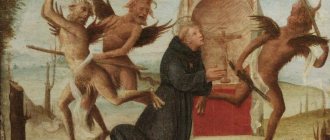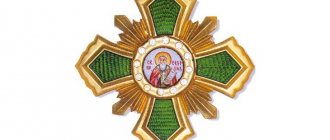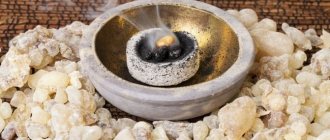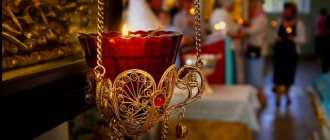Everyday
The censing is performed at the most solemn moments of the service. It can be full, when the clergyman walks around the entire temple with a censer, and small, when censing is performed in the altar and in front of the iconostasis.
Photo by Vladimir Eshtokin
Before censing, the priest blesses the censer and reads a prayer:
We offer the censer to You, Christ our God, into the stench (smell) of the spiritual fragrance, which is received into Your heavenly mental altar, bestow upon us the grace of Your Most Holy Spirit.
When a priest burns incense on a throne, icons, or other sacred objects, he gives God due honor and praise. The censer facing people symbolizes the blessing and descent of the Holy Spirit. In response to censing, it is customary to bow.
When a priest serves together with a deacon, the latter performs almost all incense. This is one of his main duties, along with reading special prayers (litanies). That is why, in the Orthodox tradition, a deacon is buried with a censer in his hands.
History of origin
The division was established in the Old Testament by God himself. The Lord commanded Moses to make an altar for incense and gave clear instructions for its construction:
Holy of Holies in the Temple of King Solomon, 1995. Artist Zeliy Smekhov
And thou shalt make an altar for offering incense, of shittim wood thou shalt make it: the length thereof shall be a cubit, and the breadth thereof shall be a cubit; it must be quadrangular; and the height of it is two cubits; its horns [should come out of it]; overlay it with pure gold, the top thereof, the sides thereof, and the horns thereof; and make a golden crown around it; under his crown, at his two corners, make two rings of gold; make them on both sides of it; and they will be sheaths for poles to carry him on; Make the poles of shittim wood and overlay them with gold. And you shall place him before the veil that is before the ark of the testimony, against the mercy seat that is on the [ark] of the testimony, where I will reveal myself to you.
On it Aaron will burn sweet incense; every morning, when he prepares the lamps, he will smoke with them; and when Aaron lights the lamps in the evening, he will incense with them: [this] is an everlasting incense before the Lord throughout your generations. You shall not offer on it any other incense, nor burnt offering, nor grain offering, nor pour out any drink offering on it (Exod. 30:1–9).
Stationary censer, Byzantium-Syria, 6th century. Photo: https://ruvera.ru
The incense altar is a prototype of the modern censer. Initially, all censers were stationary and consisted of a large bowl on legs, into which burning coal was placed, onto which incense was poured with a special scoop.
In parallel with stationary censers, manual ones began to appear. In shape, they resembled a frying pan or a cylinder with holes on a long handle, into which everything needed for incense was poured.
What is fragrant oil: how is it made, how to use it?
Church oil itself is consecrated, but if you do not believe, then it will be of no use. The main task is to believe in the saints, as well as in God, and pray, turning during healing or anointing. Only in this case will the result be visible. Also, do not overdo it, use prayer, as well as anointing with oil, to solve ordinary everyday problems that you can easily solve on your own.
The clergy advise using this kind of oil in extreme cases, when there is really a need for it. To save church oil, a cotton swab is dipped into it and crosses are placed on the forehead. This helps to get rid of troubles, as well as help in difficult life situations.
When you buy oil in a church shop, there must be an inscription on it stating what it is and how it was made. Most often, myrrh is written on it. This remedy should be considered healing and used to treat a variety of ailments.
Incense oil
Fragrance oil is also called myrrh, it is brewed by the archbishop, it is a mixture of olive oil and 40 different resins, extracts and essential oils. This whole mixture is cooked for a long period of time. The most interesting thing is that the cooking process takes several days. During the manipulation, the Gospel is read and the sacred liquid is stirred. To prevent it from catching fire, white wine is added to it. After this, you can use this oil. It is poured into barrels and delivered to churches. This oil is prepared every 2 or 4 years.
Oil
Mainly in ancient times, a similar composition was used to anoint clergy, as well as kings, or some courtiers. Now a similar composition can be bought at any church store.
Modern look
Photo by Ilya Svinkovsky
Christians began to use censer during worship starting in the 6th century. They were similar in shape to modern ones: it was a small bowl or sphere on three chains that were connected together. Initially there was no lid - all the elements were of practical importance.
Censer, Byzantium, 6th century. Photo: https://ruvera.ru
Censers with chains came to Rus' from Byzantium in the 11th century. In the 15th century, they took on the form of a temple: a lid in the form of a church dome with holes for air and incense, which ended with a cross, was added to the coal bowl.
Censer, Moscow, late 15th century. Photo: https://ruvera.ru
A 4th chain was attached to it, with which you can lift the lid up and gain access to the coal bowl. The modern censer in the Orthodox Church looks exactly like this.
Read also
Incense
Incense Ruler: Sun. Type: tree resin. Magic form: balls, powder, oil. Incense is burned to cleanse a room, driving out evil from it, and to attract happiness and health. Incense
Incense
Frankincense Frankincense is the dried sap and gum of a tree of the genus Boswellia, which belongs to the Burzer family. Frankincense-producing trees grow in the Arabian Peninsula, East Africa and India. They are quite rare. In appearance, trees growing in different
Lamp oil, incense and other attributes
Lamp oil, incense and other attributes Among church and liturgical attributes, oil from holy relics and miraculous icons is highly respected. Particularly revered is oil from Kyiv, from the Holy Sepulcher, and from Mount Athos - New and Old. Last in some
Jean Dixon: "Light incense and look in the mirror"
Jean Dixon: “Light incense and look in the mirror” Jean Dixon was an American astrologer and psychic (died in 1997), who achieved great fame in her homeland thanks to her astrology column in one of the newspapers, and also attracted attention
Source
Katsia
Photo: https://ruvera.ru
Katsia is a hand censer in the shape of a ladle. It was used in ancient times in the East and in Rus' before the advent of censers with chains.
Katsia on the miniature “Funeral service and burial of Prince Vladimir Volodarevich.” Radzivilov Chronicle, end of the 15th century.
Katsia is still used during services in the Greek Church and by Old Believers; it is practically not used in the Russian Orthodox Church.
The shape of the censer, which is used by the laity at home during prayer, is very similar to the cation.
Varieties of blessed church oil
There are several varieties of oils that can be found in a church. Basically, this myrrh is nothing more than an oil that is secreted by sacred relics. Myrrh is collected, diluted with olive oil or Vaseline, blessed and sold in church shops. This is a composition that will help get rid of many chronic diseases, as well as heal the soul and body. In addition, you can find lamp oil in the church.
It is added to the lamp during services for a pleasant aroma. This mixture is nothing more than olive oil with the addition of various essential oils and incense. This oil is also illuminated and used for medicinal purposes. Please note that church oil should be stored directly in the lamp, near the icons in your home. Under no circumstances should this substance be placed near cosmetics and perfumes, or in jars in the bathroom. This is not a cosmetic composition, but a medicinal remedy.
Miro
Incense
Incense is an aromatic tree resin and incense. When burned in a censer, it symbolically expresses man's reverence for God.
After the birth of Jesus Christ, the wise men brought Him gifts of gold, incense and myrrh. These gifts are prophetic and symbolic - in particular, incense was presented to the Savior as the High Priest and God.
Incense
Real incense is the resin of a rare tree, which we call Lebanese cedar. To get as much of it as possible, small cuts are made on the tree trunk from which it flows. The hardened resin is collected, crushed and mixed with water and aromatic oils.
The resulting paste is rolled out and cut into small pieces, which are sprinkled with white powder - magnesia. This is necessary so that the incense, when stored in the package, does not stick together into one lump and you can take the right amount. Nowadays incense is made from different types of oriental trees.
Lamp oil and oil
Please note that lamp oil is nothing more than olive oil with the addition of incense in order to perform rituals. Yes, if it is lit, sold in a church shop, you can purchase it, but you should not eat it. This is nothing more than a product that is poured directly into the lamp. Oil is olive oil of the poorest purity, used for the preparation of other church oils. The oil is mixed with other oils that are blessed on the relics and is distinguished by its healing properties. This remedy is used for treatment and healing. Please note that neither oil nor lamp oil is used to illuminate the home, unlike holy water.
Church oils
Cistus
Incense. Copper, casting, filigree enamel. Veliky Ustyug, XVII century.
In the ancient Church, incense was kept in a special incense box in the altar of the temple. As a rule, this is a small metal box of regular geometric shape with a dome-shaped lid.
Incense in the shape of a five-domed temple with floral ornaments. Photo: https://ruvera.ru
Nowadays there is no mandatory practice of storing incense in it.
